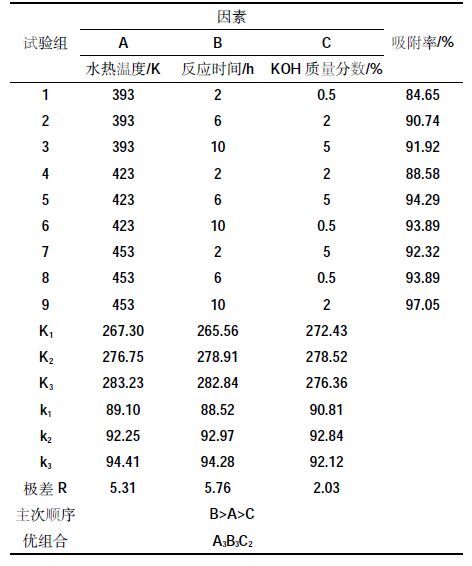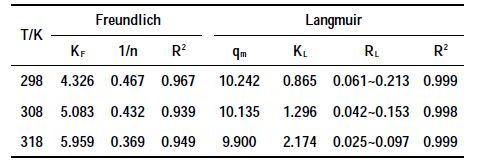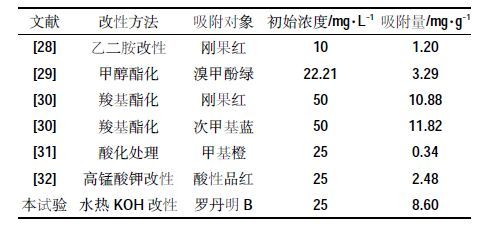文章信息
- 陈春强, 吴娟, 邬欣慧, 马东
- CHEN Chun-qiang, WU Juan, WU Xin-hui, MA Dong
- 水热氢氧化钾改性花生壳对染料的吸附性能
- Preparation and adsorption performance of peanut shells based adsorbent by potassium hydroxide-assisted hydrothermal method
- 农业环境科学学报, 2016, 35(11): 2224-2230
- Journal of Agro-Environment Science, 2016, 35(11): 2224-2230
- http://dx.doi.org/10.11654/jaes.2016-0784
文章历史
- 收稿日期: 2016-06-11
2. 东北农业大学资源与环境学院, 哈尔滨 150030
2. College of Resources and Environmental Science, Northeast Agricultural University, Harbin 150030, China
染料在生产和使用过程中,会不可避免地进入环境。由于染料具有致癌、致畸、致突变作用,其进入水环境会对水生生物及人类饮用水安全造成严重威胁。因此,如何去除水环境中的染料是环境污染控制领域的一个研究热点[1]。对水环境中染料的处理方法主要有吸附、絮凝沉淀、化学氧化、生物降解等[2-5]。吸附法以其处理量大,吸附剂种类众多而被广泛运用。传统吸附剂主要有活性炭、高岭土、工业炉渣、硅聚物等,但这些吸附剂具有成本高,不易再生的弊端,开发一种低成本高效率的新型吸附剂显得十分重要[6]。
目前,以秸秆、花生壳、玉米芯和木屑等农林废弃物为原料,利用高温炭化、酸碱活化等改性方法制备生物质吸附剂[7-10],并将其用于吸附废水中的重金属和染料等污染物,获得了较好的试验结果。但这些改性方法能耗较高,产率较低,且制备过程产生废气。因此,在制备过程方面仍有待改进和完善。水热法是制备功能材料的传统方法,由于反应条件温和而得到广泛应用[11]。水热法可在特定亚临界状态将大量碳质成分及活性官能团通过溶解、聚合、碳化、交联等化学过程枝接于生物质表面[12],具有简单经济高效的特点,且可大量制备。本课题组已经通过水热法改性棉铃壳、竹叶、花生壳等农林废弃物,吸附废水中的F-和Cr(Ⅵ),均取得较好的吸附效果。
花生壳是一种典型的农林废弃物,至今未得到充分的利用[13]。本试验以花生壳为原料,利用氢氧化钾活化和水热改性两步法制备改性花生壳吸附剂,通过正交试验确定了制备吸附剂的最佳条件,并研究其对废水中罗丹明B(Rhodamine B)的吸附性能,以期为改性花生壳吸附剂在染料废水处理中的应用提供参考。
1 材料与方法 1.1 主要仪器与试剂利用JEOL-7500F 型扫描电子显微镜观察改性花生壳吸附剂的表面形貌,测定前需进行喷金处理。利用IR200 型傅里叶变换红外光谱仪分析吸附剂的表面基团。其他仪器:AR2140 电子分析天平,pH211型酸度计,722E 可见分光光度计,SHZ-82A 水浴恒温振荡器。主要试剂KOH、NaOH、HCl、罗丹明B(Rh B)等均为分析纯,试验所用水为去离子水。
1.2 吸附剂的制备将新鲜花生壳洗净烘干粉碎后,过80 目筛备用。将适量花生壳浸入质量分数0.5%~5%的KOH 溶液,静置30 min 后,将混合液转入100 mL 水热反应釜中,在393~453 K下水热反应2~10 h。反应结束后冷却至室温,经过滤、洗涤、真空烘干后,研磨得到水热KOH改性花生壳吸附剂。
1.3 静态吸附试验称取0.15 g改性花生壳于150 mL 锥形瓶中,加入50 mL 一定浓度的Rh B 溶液,用0.1 mol·L-1 的HCl 和NaOH 调节溶液pH,置于水浴恒温振荡器中振荡一定时间,静置10 min 后离心分离,取上清液用分光光度法测定溶液中剩余Rh B浓度。
2 结果与讨论 2.1 扫描电镜与红外光谱分析改性花生壳吸附剂的扫描电镜照片见图 1。在放大100倍和300 倍的照片中(图 1a、图 1b),改性花生壳表面疏松,呈条带或片状,片层边界坍塌,加剧了表面粗糙程度。在放大1000 倍和5000 倍的照片中(图 1c、图 1d),薄片呈轻微弯曲状且有裂隙,出现不规则的孔道。这是由于花生壳经水热改性后,有能量从内部骤然释放出来,导致形成裂隙孔结构[15],使之具有较强的吸附能力。

|
| 图 1 改性花生壳吸附剂的扫描电镜图 Figure 1 SEMimages of modified peanut shells adsorbent |
花生壳改性前后红外光谱图见图 2。波数1618、1066、949 cm-1 处对应的是C=C、C-O 键的振动,该振动峰在花生壳改性前后均存在,说明水热改性未对花生壳的表面基团产生明显影响。花生壳经水热KOH改性后,分子间O-H 键在3500 cm-1和3400 cm-1 处存在不对称和对称两种伸缩振动;羧酸盐中的C-O发生部分离域,分别在1600 cm-1和1400 cm-1处出现不对称和对称伸缩振动的吸收峰;1000~650 cm-1 处出现C-H 弯曲振动;指纹区1200~800 cm-1 处的C-C单键伸缩振动强度减弱。这说明水热KOH改性过程中的脱水及碳化作用[16],破坏了原材料中的纤维素、半纤维素结构,形成丰富的官能团,从而使改性花生壳吸附剂对Rh B具有较强的吸附能力。
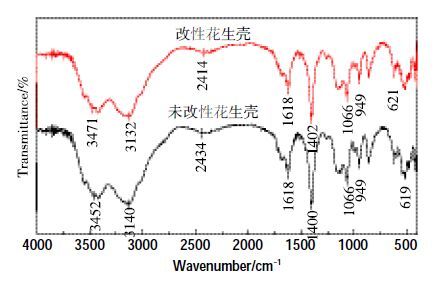
|
| 图 2 花生壳改性前后的傅里叶红外光谱图 Figure 2 FTIR spectra of peanut shells before andafter modification |
根据正交试验设计方法,选定水热温度、水热反应时间和KOH质量分数三个主要影响因素,通过等水平正交试验(表 1)进行优化。
试验制得9 组水热KOH 改性花生壳吸附剂,为了判断改性条件对Rh B 吸附率的影响,确定最佳优化条件,采用极差分析法进行分析,其结果见表 1。水热KOH 改性花生壳的最优制备条件为:水热温度453 K、反应时间10 h、KOH 质量分数2%。三个影响因素中,水热反应时间影响最大,改性剂浓度的影响最小。最优制备条件下得到的水热改性花生壳吸附剂在Rh B浓度为5 mg·L-1、改性花生壳投加量3 g·L-1的条件下,对Rh B的吸附率可达97.05%。
改性花生壳投加量对Rh B 吸附率影响如图 3 所示。当改性花生壳投加量为0.5~1.5 g·L-1时,随着投加量的增加吸附率迅速增加,由74.6%增大到93.5%;当投加量由1.5 g·L-1增至3 g·L-1时,吸附率的增速趋于缓慢。这是由于投加量较低时,吸附剂表面少量的吸附位点与Rh B结合呈现饱和状态,导致溶液中剩余的Rh B较多[17]。随着投加量的增加,吸附剂表面积增加,提供了更多的吸附位点,使Rh B更易与吸附位点结合。当投加量为3 g·L-1时,基本达到吸附饱和。因此,后续试验以1.5 g·L-1作为最佳投加量。
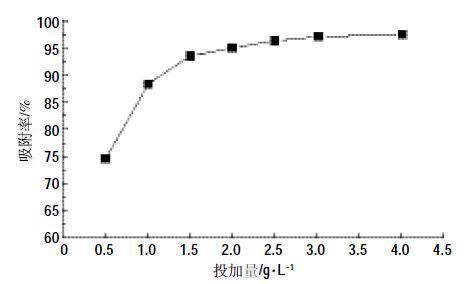
|
| 图 3 吸附剂投加量对吸附率的影响 Figure 3 Effect of adsorbent dosage on removal efficiency of Rh B |
称取0.15 g改性花生壳,分别放入100 mL 浓度为5~25 mg·L-1的Rh B 溶液中,室温下振荡120 min,得到不同Rh B初始浓度与吸附率的关系曲线(图 4)。随着Rh B初始浓度的增大,改性花生壳对RhB的吸附率逐渐降低。由于改性花生壳表面的吸附位点是固定的,随着Rh B浓度的增大,吸附剂表面的吸附位点逐渐被占据使RhB过剩,从而吸附率降低[18-19]。
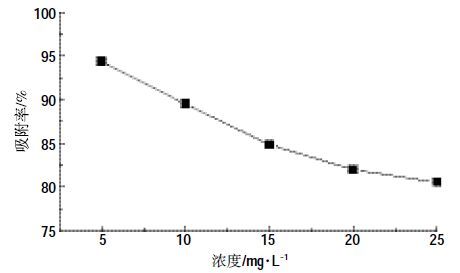
|
| 图 4 溶液初始浓度对Rh B吸附率的影响 Figure 4 Effect of initial concentration on Rh B removal efficiency |
考察了溶液pH 值对Rh B 吸附率的影响。由图 5可知,溶液pH值对Rh B的吸附率影响较大。当pH=2.0时,改性花生壳对Rh B的吸附率达到96.6%;当pH>2.0 时,对Rh B的吸附率呈快速下降的趋势。这与改性花生壳表面功能基团的带电状态及Rh B在水溶液中的存在形态有关[20]:当pH 值较低时,表面功能基团呈负电性,Rh B会通过静电作用吸附在花生壳表面,使吸附剂和附着离子间的静电吸引力得到了增强[21];在pH 值较高时,溶液中H-逐渐增多,改性花生壳的吸附点位被OH-夺走,导致对Rh B的吸附率明显降低。因此,在酸性条件下改性花生壳对Rh B的吸附效果较好。

|
| 图 5 pH 对Rh B吸附率的影响 Figure 5 Effect of pH value on removal efficiency of Rh B |
吸附时间对Rh B 吸附量的影响如图 6 所示。随着吸附时间增加,改性花生壳对Rh B的吸附量逐渐增加,至90 min 时达到吸附平衡,此后随着时间的增加,吸附量不再有明显增加。这是由于在吸附初期,Rh B浓度较大,其向吸附剂表面扩散的速度较快,故对其吸附量较大,属于快速吸附时期;随着吸附过程的进行,溶液中Rh B的浓度逐渐降低,扩散速度相应减慢,同时伴随着吸附剂表面有效的吸附位点减少,吸附速度开始下降,并逐渐达到吸附平衡,属于平衡吸附期[22]。图 6 中,Rh B 溶液初始浓度为5、15、25mg·L-1时,水热改性花生壳对Rh B的平衡吸附量分别为2.64、6.91、8.60 mg·g-1。
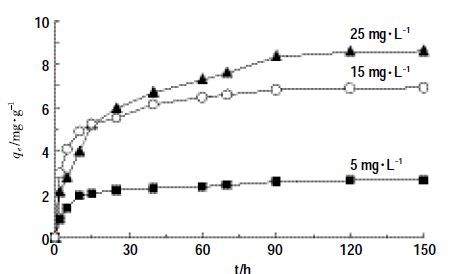
|
| 图 6 吸附时间对不同初始浓度Rh B吸附量的影响 Figure 6 Effect of time on adsorption capacity of Rh B |
本文采用伪一级和伪二级吸附动力学模型描述和分析Rh B浓度随吸附时间的变化关系[23]。通过两种动力学模型及颗粒内扩散模型对其吸附曲线进行拟合,探究水热KOH 改性花生壳对Rh B的吸附机理,得到动力学参数如表 2 和图 7 所示。
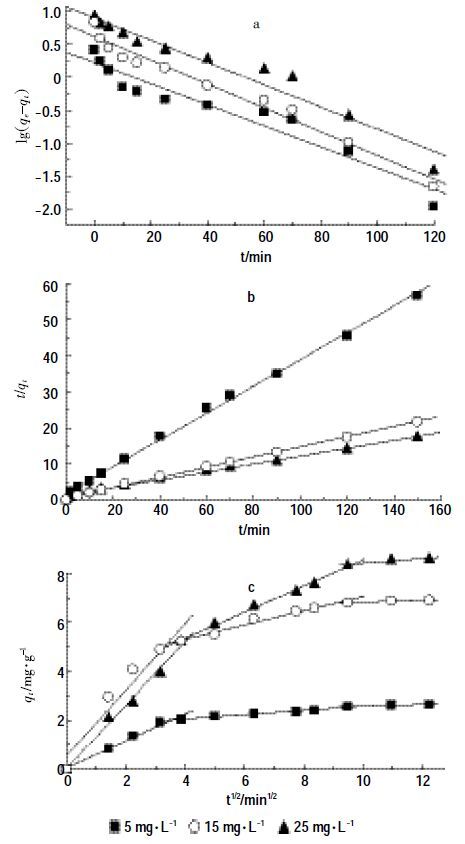
|
| 图 7 吸附动力学线性拟合曲线 Figure 7 The adsorption kinetics curves by linear fitting a 伪一级模型;b 伪二级模型;c颗粒内扩散模型 a:Pseudo-first-order model;b:Pseudo-second-order model;c:Intraparticle diffusion model |
吸附动力学拟合结果表明,伪一级动力学模型线性相关性明显低于伪二级动力学模型。伪二级动力学模型线性相关系数均在0.99 以上,且伪二级吸附速率模型包含了吸附的所有过程[24],能够真实地反映吸附机理。由此可见,伪二级动力学模型能更好地描述改性花生壳对Rh B的吸附过程。
2.5 吸附热力学分析采用Langmuir 和Freundlich 两种吸附等温方程分别对298 K、308 K和318 K的吸附试验数据进行拟合,结果见表 3。在不同温度下,Langmuir 等温吸附模型和Freundlich 等温吸附模型均能较好地描述其吸附过程,但Langmuir 等温吸附模型更符合改性花生壳对Rh B的吸附过程,且相关系数更接近于1。在本次试验的浓度范围内,等温方程特征分离系数RL在0~1之间,说明改性花生壳对Rh B的吸附为优惠吸附[25],主要为单分子层吸附。
根据试验数据可得到不同温度下的△G 值,对lnb 和1/T进行线性回归(R2=0.993 1),拟合数据见表 4。可见,改性花生壳对Rh B 吸附过程的驻H>0,△G<0,说明该过程是自发的吸热过程,且随着温度的升高,△G 的绝对值增大,表明升温有利于改性花生壳对Rh B的吸附[26]。本试验中,△G 为-5.403~ -8.110kJ·mol-1,表明水热改性花生壳对Rh B的吸附以物理吸附为主[27]。
将本试验制得的花生壳吸附剂与其他改性花生壳吸附剂对染料的吸附性能进行比较,结果见表 5。经比较,本文中水热KOH改性花生壳吸附剂的吸附量与其他改性方法吸附剂相比,具备明显的优势。
(1)采用正交试验考察了制备改性花生壳的最优条件,在水热改性温度453 K、反应时间10 h、KOH 质量分数2%的条件下制得的吸附材料对Rh B 吸附量最高。在Rh B浓度为5 mg·L-1、吸附时间120 min、投加量1.5 g·L-1时,Rh B吸附率最高,达93.50%。水热KOH 改性花生壳吸附剂对染料的吸附性能明显优于其他同类改性花生壳吸附材料。
(2)通过不同吸附动力学模型拟合改性花生壳对Rh B的吸附行为,伪二级动力学模型拟合相关系数均在0.99 以上,线性相关性较好,表明吸附过程更符合伪二级动力学模型。
(3)等温吸附试验结果表明,Langmuir 吸附等温方程能更好地描述改性花生壳对Rh B的吸附过程,主要为单分子层吸附。吸附热力学过程的△H>0、△G<0,说明该过程是自发的吸热过程,且主要为物理吸附。
| [1] | Gadd G M. Biosorption:critical review of scientific rationale, environmental importance and significance for pollution treatment[J]. Journal of Chemical Technology and Biotechnology , 2009, 84 (1) : 13–28. DOI:10.1002/jctb.v84:1 |
| [2] | Basar C A. Applicability of the various adsorption models of three dyes adsorption onto activated carbon prepared waste apricot[J]. Journal of Hazardous Materials , 2006, 135 (1-3) : 232–241. DOI:10.1016/j.jhazmat.2005.11.055 |
| [3] | Bae W, Won H, Hwang B, et al. Characterization of refractory matters in dyeing wastewater during a full -scale Fenton process following pure-oxygen activated sludge treatment[J]. Journal of Hazardous Materials , 2015, 287 : 421–428. DOI:10.1016/j.jhazmat.2015.01.052 |
| [4] | 方明晖, 詹树林, 林俊雄, 等. 活性染料废水的混凝处理研究[J]. 工业水处理 , 2007, 27 (2) : 26–29. FANG Ming-hui, ZHAN Shu-lin, LIN Jun-xiong, et al. Study on the coagulation treatment of activated dye wastewater[J]. Industrial Water Treatment , 2007, 27 (2) : 26–29. |
| [5] | Rafatullah M, Sulaiman O, Hashim R, et al. Adsorption of methylene blue on low-cost adsorbents:A review[J]. Journal of Hazardous Materials , 2010, 177 (1/2/3) : 70–80. |
| [6] | 党艳, 罗倩, 李克斌, 等. 荞麦皮生物吸附去除水中罗丹明B的吸附条件响应面法及热力学研究[J]. 环境科学学报 , 2011, 31 (12) : 2601–2608. DANG Yan, LUO Qian, LI Ke-bin, et al. Biosorption of Rhodamine B by buckwheat hull:Response surface methodology and thermodynamics study[J]. Acta Scientiae Circumstantiae , 2011, 31 (12) : 2601–2608. |
| [7] | 李瑞月, 陈德, 李恋卿, 等. 不同作物秸秆生物炭对溶液中Pb2+, Cd2+的吸附[J]. 农业环境科学学报 , 2015, 34 (5) : 1001–1008. LI Rui-yue, CHEN De, LI Lian-qing. Adsorption of Pb2+ and Cd2+ in aqueous solution by biochars derived from different crop residues[J]. Journal of Agro-Environment Science , 2015, 34 (5) : 1001–1008. |
| [8] | Xu R K, Xiao S C, Yuan J H, et al. Adsorption of methyl violet from aqueous solutions by the biochars derived from crop residues[J]. Bioresource Technology , 2011, 102 (22) : 10293–10298. DOI:10.1016/j.biortech.2011.08.089 |
| [9] | Feng Y, Dionysiou D D, Wu Y, et al. Adsorption of dyestuff from aqueous solutions through oxalic acid-modified swede rape straw:Adsorption process and disposal methodology of depleted bioadsorbents[J]. Bioresource Technology , 2013, 138 (2) : 191–197. |
| [10] | 吴艳, 罗汉金, 王侯. 改性木屑对水中刚果红的吸附性能研究[J]. 环境科学学报 , 2014, 34 (7) : 1680–1688. WU Yan, LUO Han-jin, WANG Hou. Adsorption properties of modified sawdust for Conge red removal from wastewater[J]. Acta Scientiae Circumstantiae , 2014, 34 (7) : 1680–1688. |
| [11] | 梁吉雷, 吴明铂, 刘以红, 等. 生物质水热合成炭微球研究进展[J]. 化工新型材料 , 2011, 39 (4) : 1–4. LIANG Ji-lei, WU Ming-bo, LIU Yi-hong, et al. Progress in carbon microspheres prepared from biomass by hydrothermal carbonization[J]. New Chemical Materials , 2011, 39 (4) : 1–4. |
| [12] | 吴娟, 崔春月, 马东. 水热改性棉铃壳对水中氟的吸附[J]. 环境工程学报 , 2013, 7 (9) : 3289–3295. WU Juan, CUI Chun-yue, MA Dong. Adsorption of fluoride in water on modified cotton shell by hydrothermal method[J]. Chinese Journal of Environmental Engineering , 2013, 7 (9) : 3289–3295. |
| [13] | 张再利, 况群, 贾晓珊. 花生壳吸附Pb2+, Cu2+, Cr3+, Cd2+, Ni2+的动力学和热力学研究[J]. 生态环境学报 , 2010, 19 (12) : 2973–2977. ZHANG Zai -li, KUANG Qun, JIA Xiao-shan. Study on the kinetics and thermodynamics of Pb2+, Cu2+, Cr3+, Cd2+, Ni2+ adsorption onto peanut hull[J]. Ecology and Environment , 2010, 19 (12) : 2973–2977. |
| [14] | Wilson K, Yang H, Seo C W, et al. Select metal adsorption by activated carbon made from peanut shells[J]. Bioresource Technology , 2006, 97 (18) : 2266–2270. DOI:10.1016/j.biortech.2005.10.043 |
| [15] | 何娇, 孔火良, 高彦征. 表面改性秸秆生物质环境材料对水中PAHs的吸附性能[J]. 中国环境科学 , 2011, 31 (1) : 50–55. HE Jiao, KONG Huo-liang, GAO Yan-zheng. Removal of PAHs from aqueous solution by the surface modified-stalk environmental biomaterials[J]. China Environmental Science , 2011, 31 (1) : 50–55. |
| [16] | Wang N, Tahmasebi A, Yu J, et al. A comparative study of microwave-induced pyrolysis of lignocellulosic and algal biomass[J]. Bioresource Technology , 2015, 190 : 89–96. DOI:10.1016/j.biortech.2015.04.038 |
| [17] | 赵凌宇, 王延华, 杨浩, 等. 木屑和稻秆基生物质炭对汞的吸附特性比较[J]. 农业环境科学学报 , 2015, 34 (3) : 556–562. ZHAO Ling-yu, WANG Yan-hua, YANG Hao, et al. Adsorption of Hg(Ⅱ) by biochars produced from sawdust and rice straw[J]. Journal of Agro-Environment Science , 2015, 34 (3) : 556–562. |
| [18] | Sun L, Wan S, Luo W. Biochars prepared from anaerobic digestion residue, palm bark, and eucalyptus for adsorption of cationic methylene blue dye:Characterization, equilibrium, and kinetic studies[J]. Bioresource Technology , 2013, 140 (2) : 406–413. |
| [19] | Feng Y, Zhou H, Liu G, et al. Methylene blue adsorption onto swede rape straw(Brassica napus L.) modified by tartaric acid:Equilibrium, kinetic and adsorption mechanisms[J]. Bioresource Technology , 2012, 125C (12) : 138–144. |
| [20] | 储磊, 刘少敏, 陈天明, 等. KOH活化花生壳生物质炭对亚甲基蓝吸附性能研究[J]. 环境工程学报 , 2014, 8 (11) : 4737–4742. CHU Lei, LIU Shao-min, CHEN Tian-ming, et al. Adsorption of methylene blue by peanut shell bio-char with KOH activated[J]. Chinese Journal of Environmental Engineering , 2014, 8 (11) : 4737–4742. |
| [21] | Angin D. Utilization of activated carbon produced from fruit juice industry solid waste for the adsorption of Yellow 18 from aqueous solutions[J]. Bioresource Technology , 2014, 168 (3) : 259–266. |
| [22] | 李道荣, 王霞, 张坤峰, 等. 氮掺杂TiO2对水中Cr(Ⅵ)的吸附[J]. 环境工程学报 , 2013, 7 (1) : 185–190. LI Dao-rong, WANG Xia, ZHANG Kun-feng, et al. Adsorption of Cr(Ⅵ) from aqueous solution by N-doped TiO2[J]. Chinese Journal of Environmental Engineering , 2013, 7 (1) : 185–190. |
| [23] | 曹美珠, 潘丽萍, 张超兰, 等. 四种生物质炭的表面特性及其水溶液中镉-阿特拉津的吸附性能研究[J]. 农业环境科学学报 , 2014, 33 (12) : 2350–2358. CAO Mei-zhu, PAN Li-ping, ZHANG Chao-lan, et al. Surface characteristics of four biochars and their adsorption of Cd and atrazine inaqueous solution[J]. Journal of Agro-Environment Science , 2014, 33 (12) : 2350–2358. |
| [24] | 孙璇, 李恋卿, 潘根兴, 等. 不同作物原料生物质炭对溶液芘的吸附特性[J]. 农业环境科学学报 , 2014, 33 (8) : 1637–1643. SUN Xuan, LI Lian-qing, PAN Gen-xing, et al. Adsorption of pyrene from aqueous solution by biochars produced from different crop residues[J]. Journal of Agro-Environment Science , 2014, 33 (8) : 1637–1643. |
| [25] | Yu J X, Chi R A, Zhang Y F, et al. A situ co-precipitation method to prepare magnetic PMDA modified sugarcane bagasse and its application for competitive adsorption of methylene blue and basic magenta[J]. Bioresource Technology , 2012, 110 (2) : 160–166. |
| [26] | Liu X, Lee D J. Thermodynamic parameters for adsorption equilibrium of heavy metals and dyes from wastewaters[J]. Bioresource Technology , 2014, 160 (2) : 24–31. |
| [27] | Liu Q S, Zheng T, Wang P, et al. Adsorption isotherm, kinetic and mechanism studies of some substituted phenols on activated carbon fibers[J]. Chemical Engineering Journal , 2010, 157 (2/3) : 348–356. |
| [28] | 王中华, 曹健, 曹雯慧. 乙二胺改性花生壳对刚果红的吸附性能[J]. 江苏农业科学 , 2014, 42 (4) : 320–322. WANG Zhong-hua, CAO Jian, CAO Wen-hui. Preparation of ethylenediamine modified peanut shell and its adsorption behavior for Congo red[J]. Jiangsu Agricultural Sciences , 2014, 42 (4) : 320–322. |
| [29] | 宋应华, 高媛. 甲醇酯化改性花生壳吸附溴甲酚绿的研究[J]. 湖北农业科学 , 2011, 50 (8) : 1558–1571. SONG Ying-hua, GAO Yuan. Study on the adsorption of bromocresol green by methanol etherified peanut hull[J]. Hubei Agricultural Sciences , 2011, 50 (8) : 1558–1571. |
| [30] | 项小燕, 游腾钟, 袁秋兰, 等. 羧基酯化改性花生壳对染料废水的吸附[J]. 应用化工 , 2014, 43 (3) : 460–464. XIANG Xiao-yan, YOU Teng-zhong, YUAN Qiu-lan, et al. Study on adsorption of dyeing wastewater by modified peanut shells[J]. Applied Chemical Industry , 2014, 43 (3) : 460–464. |
| [31] | 张宏, 张敬华, 韩润平, 等. 酸化花生壳对甲基橙的生物吸附研究[J]. 化工新型材料 , 2010, 38 (4) : 104–107. ZHANG Hong, ZHANG Jing-hua, HAN Run-ping, et al. Study on acidifing peanut shell for adsorbing methyl orange[J]. New Chemical Materials , 2010, 38 (4) : 104–107. |
| [32] | 胡巧开, 庄艳笑, 陈芳. 花生壳的改性及其对酸性品红的吸附[J]. 印染助剂 , 2016, 33 (2) : 41–46. HU Qiao-kai, ZHUANG Yan-xiao, CHEN Fang. Modification of peanut shells and its adsorption to acid fuchsin[J]. Textile Auxiliaries , 2016, 33 (2) : 41–46. |
 2016, Vol. 35
2016, Vol. 35





